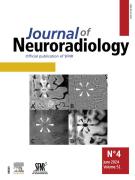Early ischemic recurrence in acute spontaneous cervical artery dissection - 18/03/23

Cet article a été publié dans un numéro de la revue, cliquez ici pour y accéder
Abstract |
Background and Purpose |
Early ischemic recurrence (EIR) following the diagnosis of acute spontaneous cervical artery dissection (CeAD) has been little investigated. We aimed to determine the prevalence and determinants on admission of EIR in a large single-center retrospective cohort study of patients with CeAD.
Methods |
EIR was defined as any ipsilateral clinical or radiological cerebral ischemia or intracranial artery occlusion, not present on admission and occurring within 2 weeks. CeAD location, degree of stenosis, circle of Willis support, presence of intraluminal thrombus, intracranial extension, and intracranial embolism were analyzed on initial imaging by 2 independent observers. Uni- and multivariate logistic regression was used to determine their association with EIR.
Results |
Two hundred thirty-three consecutive patients with 286 CeAD were included. EIR was observed in 21 patients (9%,95%CI=5–13%) with a median time from diagnosis of 1.5 days (range:0.1–14.0 days). No EIR was observed in CeAD without ischemic presentation or with less than 70% stenosis. In the remaining cases, poor circle of Willis (OR=8.5, CI95%=2.0–35.4, p = 0.003), CeAD extending to other intracranial arteries than just V4 (OR=6.8, CI95%=1.4–32.6, p = 0.017), cervical artery occlusion (OR=9.5, CI95%=1.2- 39.0, p = 0.031), and cervical intraluminal thrombus (OR=17.5, CI95%=3.0–101.7, p = 0.001) were independently associated with EIR.
Conclusions |
Our results suggests that EIR is more frequent than previously reported, and that its risk might be stratified on admission with a standard workup. In particular, the presence of a poor circle of Willis, intracranial extension (other than just V4), cervical occlusion, or cervical intraluminal thrombus are associated with high risk of EIR, for which specific management should be further evaluated.
Le texte complet de cet article est disponible en PDF.Graphical abstract |
Highlights |
• | Early ischemic recurrence (EIR) after CeAD occurs in 9% (95% CI=5–13%). |
• | EIR is exclusively observed in patients with cerebral ischemia and stenosis ≥ 70% at admission. |
• | Occlusion, intraluminal thrombus, or intracranial extension of the dissection, as well as a poor circle of Willis result in a high risk of EIR. |
Keywords : Cervical artery dissection, Cerebral ischemia, Ischemic recurrence
Abbreviations : CeAD, EIR
Plan
Bienvenue sur EM-consulte, la référence des professionnels de santé.
L’accès au texte intégral de cet article nécessite un abonnement.
Déjà abonné à cette revue ?

